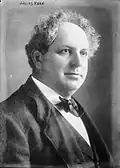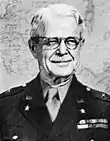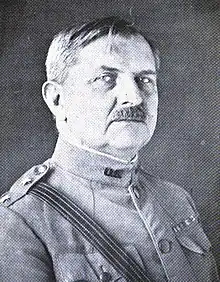National Defense Act of 1920
The National Defense Act of 1920 (or Kahn Act) was sponsored by United States Representative Julius Kahn, Republican of California. This legislation updated the National Defense Act of 1916 to reorganize the United States Army and decentralize the procurement and acquisitions process for equipment, weapons, supplies and vehicles. It was passed by Congress on June 4, 1920.

Reorganization of the Army

Advocated by John McAuley Palmer and other proponents of the National Guard, the legislation established the Army of the United States as an organization of three components: a) the Regular Army, b) the National Guard, and c) the Organized Reserve.[1] The Organized Reserve included the Officers’ Reserve Corps, Enlisted Reserve Corps and Reserve Officers Training Corps.[2]
Enhanced National Guard and Reserve role

The 1920 Act strengthened the National Guard and Organized Reserve in several ways. First, it directed that the Chief of the Militia Bureau be a National Guard officer as a way to better coordinate activities between the Army General Staff and the National Guard.[3][4] Second, it permitted National Guard officers to serve on the Army's General Staff, enhancing their training opportunities and experience, and increasing the exposure of regular Army officers to the National Guard.[5] Third, it required that the Army Staff create joint committees of Guard, Reserve and Regular Army officers when considering actions that would affect the Guard and Reserve, thus giving the Guard and Reserve input into plans and policies that could affect them.[6] The Regular Army Reserve, the most direct reserve force supplementing the Regular Army, was abolished by the National Defense Act of 1920, but was revived in 1938.
Procurement and contracting

The National Defense Act of 1920 also required the Army to conduct studies and planning for wartime mobilization, rather than waiting for war to be declared to begin planning. This shift to contingency planning and a long-range outlook led to decentralization of the contracting and procurement process, and increased coordination between military leaders and leaders of business and industry. The need for specialists in procurement and mobilization planning led to the 1924 creation of the Army Industrial College.[7][8]
Legacy
The 1920 Act was the basis for the Army's organization through World War II, and remained largely in effect until passage of the National Security Act of 1947.[9]
References
- Christian Science Monitor, Organization of American Army, September 10, 1920
- Chicago Daily News, Almanac and Yearbook for 1921, Reorganization of the Army, 1920, pages 144-145
- Pittsburgh Press, Rickards to be Made Militia Bureau Chief, June 1, 1921
- New York Times, The New Militia Bureau Chief, January 1, 1921
- New York Times, New Army Policy Fixed by Harding, July 25, 1921
- National Guard Bureau, Today in History, June 4, 1920, 2013
- Stetson Conn, Chief of Military History, Department of the Army, Highlights of Mobilization, World War II, 1938-1942, 1959
- Army Ordnance Corps Association, Ordnance Magazine, The Army Industrial College, May–June 1924, page 352
- Frank N. Trager, The National Security Act of 1947: Its Thirtieth Anniversary, Air University Review, November–December 1977